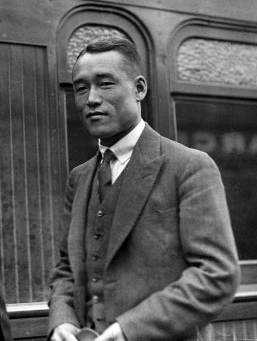Discover Your Roots
SIGN UPDiscover Your Roots
SIGN UPJiro is a male name of Japanese origin, meaning "Second Son". It is a stand-alone given name and a common name suffix for males. The name can be written using different kanji characters, such as "次郎" meaning "next, son" or "二郎" meaning "second, son". Jiro has been borne by notable individuals across various fields, including Jiro Ono, the renowned chef and owner of Sukiyabashi Jiro, and Jiro Wang, a Taiwanese actor and singer. Additionally, the name has been associated with fictional characters in media, such as Jiro in the Blue Dragon video game and Jiro Ueda, the main character in the Trick TV series. Furthermore, Jiro is also linked to the famed Sakhalin Husky of the 1958 Japanese Antarctica expedition, depicted in the 1983 Japanese film Nankyoku Monogatari.

Jiro Sato (佐藤 次郎, Satō Jirō) was a talented Japanese tennis player who rose to worldwide fame and achieved a world ranking of No. 3 in 1933. He gained recognition for his remarkable performance at Wimbledon in 1932, where he defeated the defending champion Sidney Wood. Despite facing enormous pressure, Sato continued to excel in his tennis career, defeating renowned players such as Fred Perry in the French Open quarterfinal. Tragically, Sato's life was cut short when he committed suicide during a trip to the Davis Cup in 1934, at the age of 26. His untimely death shocked the tennis world and left a lasting impact on the sport.Sato's playing style was characterized by a flat forehand drive, inspired by tennis legend Henri Cochet, and he was known for his exceptional volleying skills. He attended Waseda University and studied economics before abandoning his studies in 1933 to pursue tennis. Sato's personal life was marked by his engagement to Sanae Okada, one of Japan's top female tennis players, highlighting his deep connection to the sport.His tragic demise aboard the ship N.Y.K. Hakone Maru remains a poignant chapter in the history of tennis. Sato's legacy continues to be remembered and honored by the tennis community, serving as a reminder of the immense pressures faced by athletes and the importance of mental well-being in sports.




All images displayed on this page are sourced from Wikipedia or Wikimedia Commons.We use these images under their respective Creative Commons or public domain licenses. Wherever applicable, author attributions and license information are provided. If you believe an image is used incorrectly or outside its license terms, please contact us so that we can review and correct the issue.